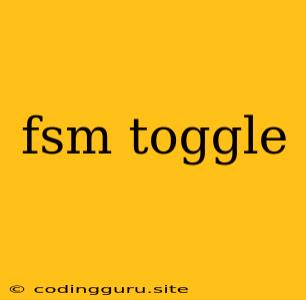Understanding and Implementing Finite State Machines with Toggles
Finite State Machines (FSMs) are a fundamental concept in computer science, providing a powerful framework for modeling and controlling complex systems. One common way to implement FSMs is using toggles, simple mechanisms that switch between states based on certain conditions.
What are Toggles?
Toggles are essentially boolean variables that control the state of an FSM. They can be either "on" or "off," representing different states in the system. Think of a light switch: it's either on or off, controlling whether the light is illuminated or not. This simple "on/off" logic is the core of a toggle.
How do Toggles Work with FSMs?
When designing an FSM with toggles, you define rules that determine how a toggle's state changes. These rules are typically based on:
- Input Events: External events that trigger transitions between states. For example, a button press could trigger a toggle to switch "on."
- Conditions: Logical expressions that evaluate to either true or false, influencing whether a toggle changes state. For example, a toggle might switch "on" if a certain value is reached.
Example: A Simple Traffic Light FSM with Toggles
Let's imagine building a traffic light controller using an FSM with toggles. We can use three toggles:
- RedToggle: Controls whether the red light is on.
- YellowToggle: Controls whether the yellow light is on.
- GreenToggle: Controls whether the green light is on.
The FSM Logic:
- Initial State: RedToggle is "on," YellowToggle and GreenToggle are "off."
- Green Light: When a timer expires, RedToggle is switched "off," and GreenToggle is switched "on."
- Yellow Light: After a certain duration, GreenToggle is switched "off," and YellowToggle is switched "on."
- Red Light: After another interval, YellowToggle is switched "off," and RedToggle is switched "on," returning to the initial state.
This simple example demonstrates how toggles can be used to implement state transitions and control the behavior of a system.
Advantages of Using Toggles for FSMs
- Simplicity: Toggles offer a straightforward way to represent states and transitions.
- Flexibility: You can easily adapt the logic by changing the conditions and rules governing the toggles.
- Clear Representation: Toggles make the FSM structure more intuitive and easy to understand.
Limitations of Toggles
While toggles are useful, they can become complex for more elaborate FSMs with multiple states. In such cases, using state machines with more sophisticated state representation and transition rules might be more suitable.
Conclusion
Using toggles is a simple yet powerful technique for implementing Finite State Machines. They provide a clear and flexible way to model state transitions based on input events and conditions. While they may be limited for highly complex systems, toggles offer a great starting point for understanding and building FSMs.
